Sun Safety at Work Canada: a multiple case-study protocol to develop sun safety and heat protection programs and policies for outdoor workers
- PMID: 26159710
- PMCID: PMC4702388
- DOI: 10.1186/s13012-015-0277-2
Sun Safety at Work Canada: a multiple case-study protocol to develop sun safety and heat protection programs and policies for outdoor workers
Abstract
Background: CAREX Canada has identified solar ultraviolet radiation (UV) as the second most prominent carcinogenic exposure in Canada, and over 75 % of Canadian outdoor workers fall within the highest exposure category. Heat stress also presents an important public health issue, particularly for outdoor workers. The most serious form of heat stress is heat stroke, which can cause irreversible damage to the heart, lungs, kidneys, and liver. Although the need for sun and heat protection has been identified, there is no Canada-wide heat and sun safety program for outdoor workers. Further, no prevention programs have addressed both skin cancer prevention and heat stress in an integrated approach. The aim of this partnered study is to evaluate whether a multi-implementation, multi-evaluation approach can help develop sustainable workplace-specific programs, policies, and procedures to increase the use of UV safety and heat protection.
Methods/design: This 2-year study is a theory-driven, multi-site, non-randomized study design with a cross-case analysis of 13 workplaces across four provinces in Canada. The first phase of the study includes the development of workplace-specific programs with the support of the intensive engagement of knowledge brokers. There will be a three-points-in-time evaluation with process and impact components involving the occupational health and safety (OHS) director, management, and workers with the goal of measuring changes in workplace policies, procedures, and practices. It will use mixed methods involving semi-structured key informant interviews, focus groups, surveys, site observations, and UV dosimetry assessment. Using the findings from phase I, in phase 2, a web-based, interactive, intervention planning tool for workplaces will be developed, as will the intensive engagement of intermediaries such as industry decision-makers to link to policymakers about the importance of heat and sun safety for outdoor workers.
Discussion: Solar UV and heat are both health and safety hazards. Using an occupational health and safety risk assessment and control framework, Sun Safety at Work Canada will support workplaces to assess their exposure risks, implement control strategies that build on their existing programs, and embed the controls into their existing occupational health and safety system.
Figures
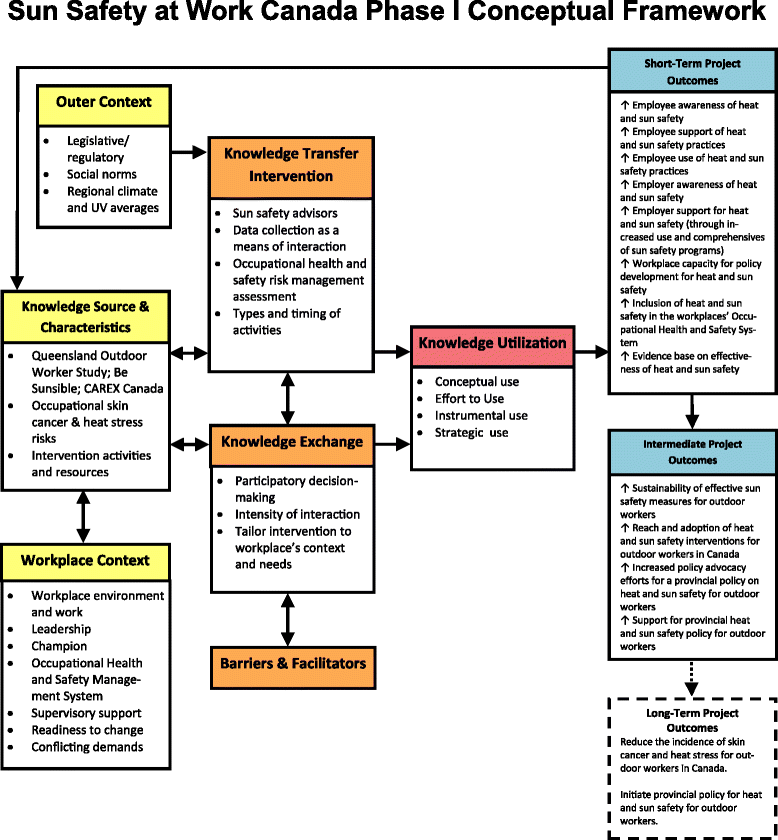
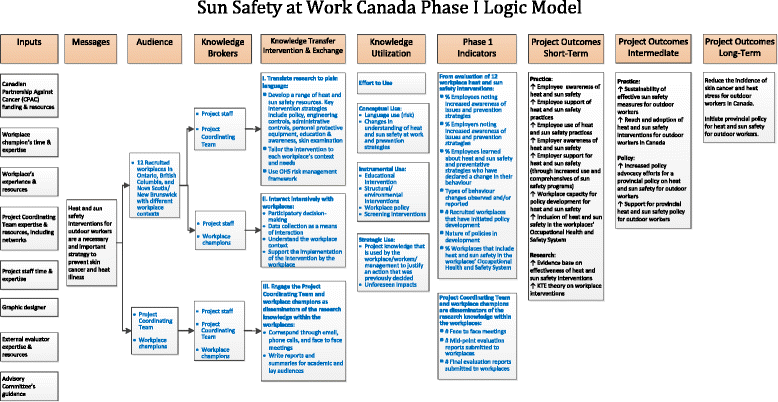
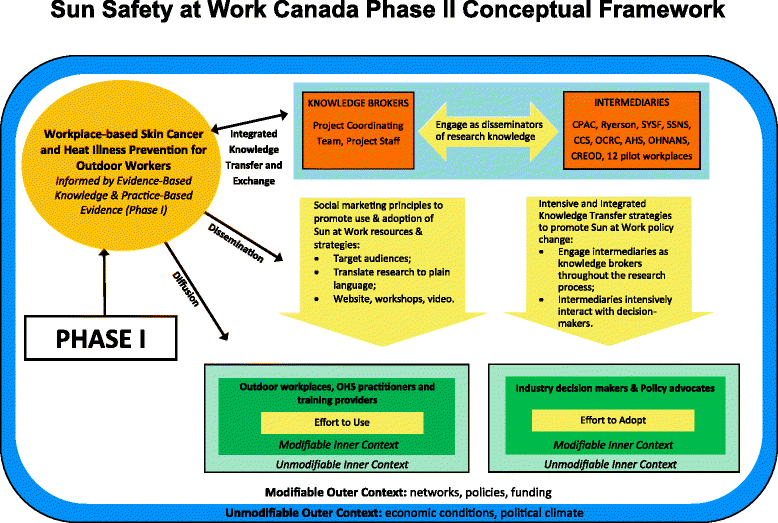
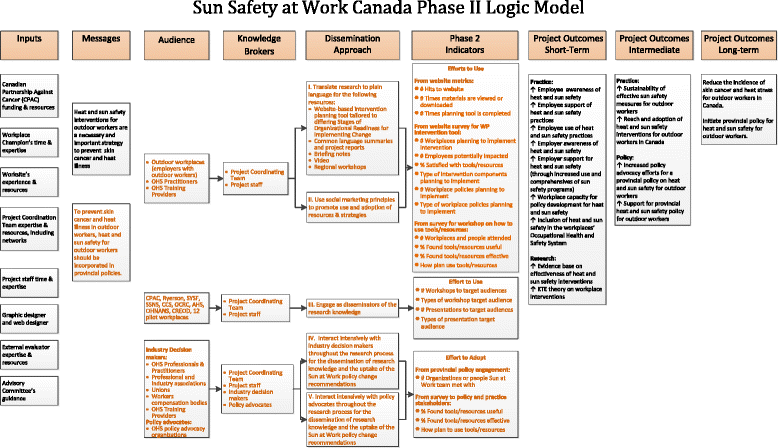
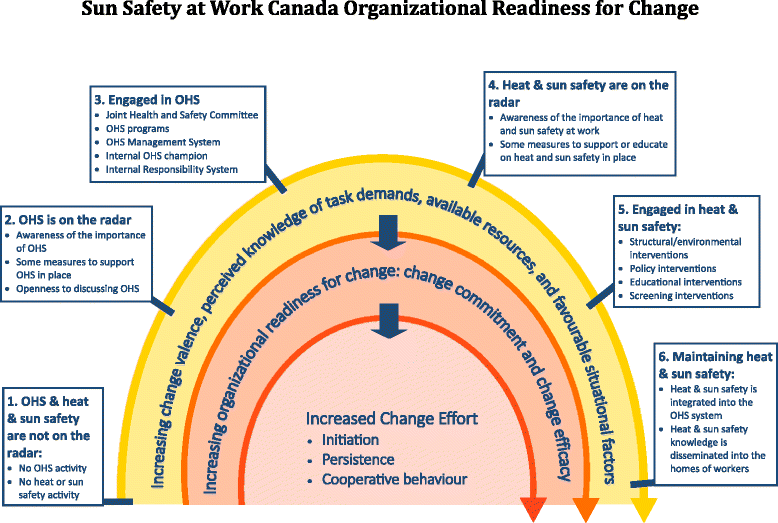
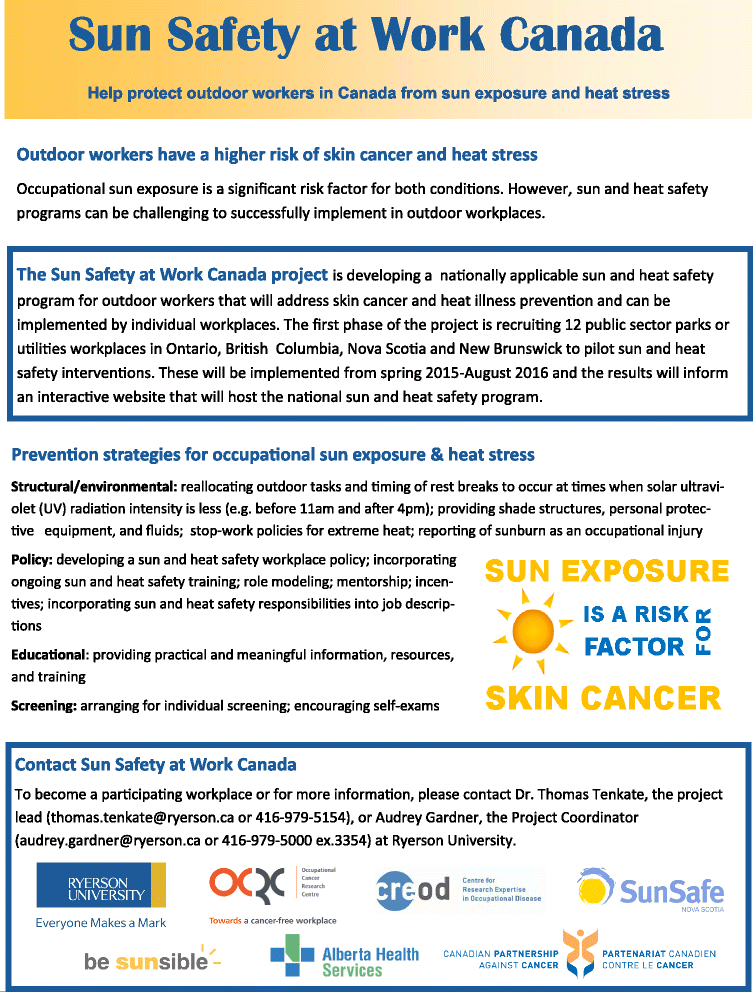
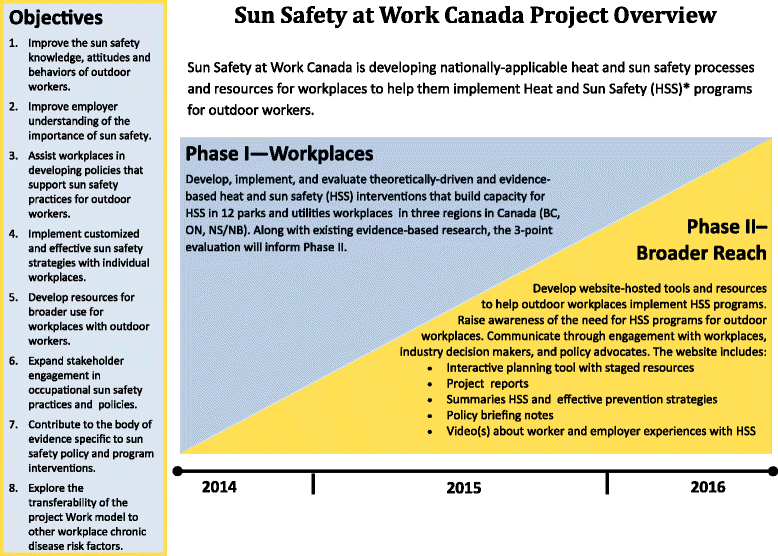
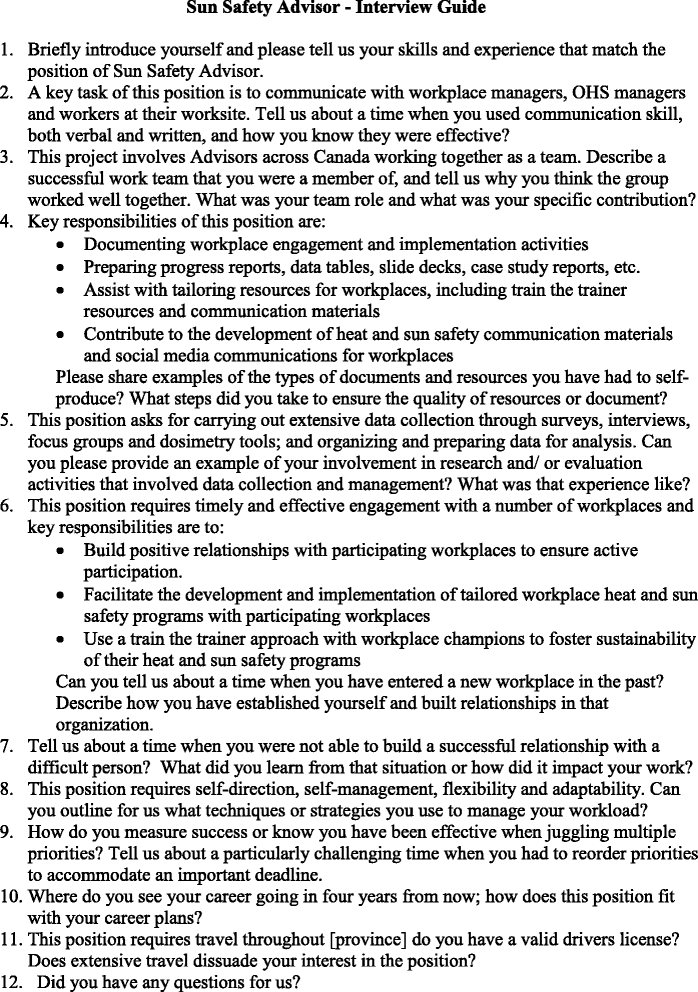

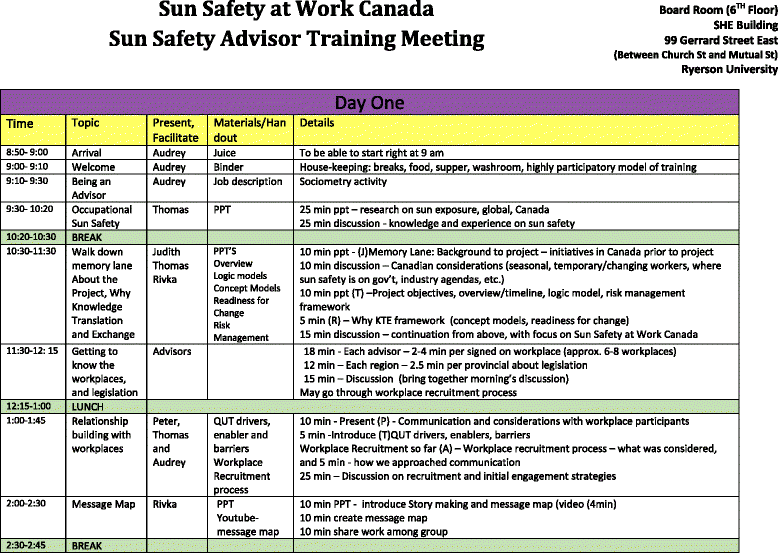
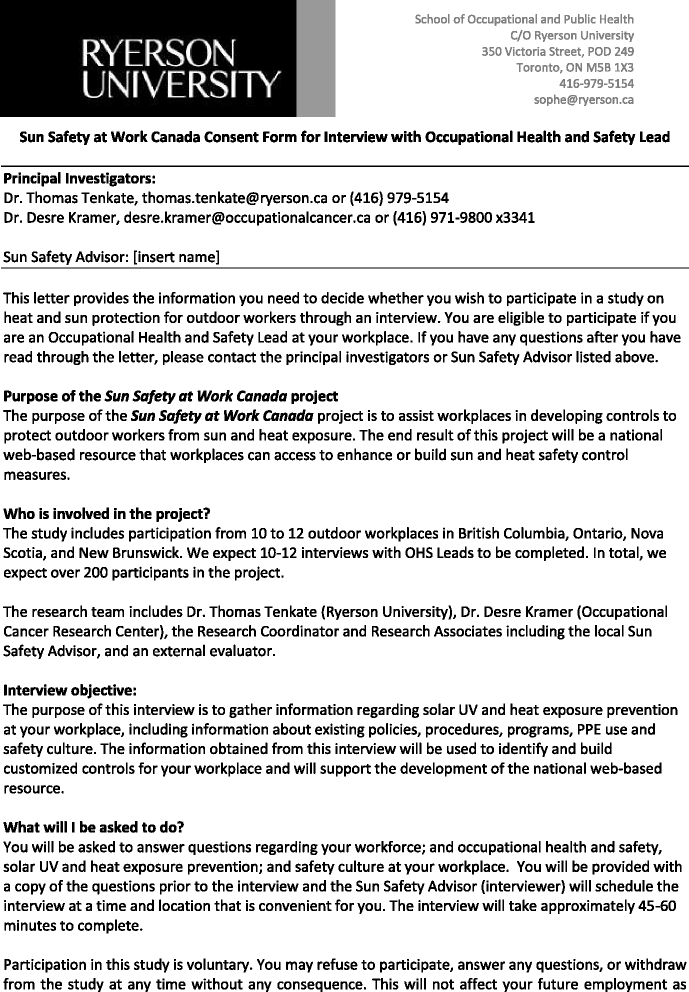
Similar articles
-
What encourages sun protection among outdoor workers from four industries?J Occup Health. 2014;56(1):62-72. doi: 10.1539/joh.13-0179-oa. Epub 2013 Nov 22. J Occup Health. 2014. PMID: 24270927
-
Factors Associated With Occupational Sun-Protection Policies in Local Government Organizations in Colorado.JAMA Dermatol. 2015 Sep;151(9):991-7. doi: 10.1001/jamadermatol.2015.0575. JAMA Dermatol. 2015. PMID: 25993051 Free PMC article. Clinical Trial.
-
Occupational sun protection: workplace culture, equipment provision and outdoor workers' characteristics.J Occup Health. 2013;55(2):84-97. doi: 10.1539/joh.12-0182-oa. Epub 2013 Feb 5. J Occup Health. 2013. PMID: 23385117
-
Reducing ultraviolet radiation exposure among outdoor workers: state of the evidence and recommendations.Environ Health. 2007 Aug 8;6:22. doi: 10.1186/1476-069X-6-22. Environ Health. 2007. PMID: 17686155 Free PMC article. Review.
-
Implementation of Ultraviolet Radiation Safety Measures for Outdoor Workers.J Cutan Med Surg. 2017 Mar/Apr;21(2):117-124. doi: 10.1177/1203475416683389. Epub 2016 Dec 9. J Cutan Med Surg. 2017. PMID: 27940497 Review.
Cited by
-
Estimating National-Level Exposure to Antineoplastic Agents in the Workplace: CAREX Canada Findings and Future Research Needs.Ann Work Expo Health. 2017 Jul 1;61(6):656-658. doi: 10.1093/annweh/wxx042. Ann Work Expo Health. 2017. PMID: 28595280 Free PMC article.
-
Burden of non-melanoma skin cancer attributable to occupational sun exposure in Canada.Int Arch Occup Environ Health. 2019 Nov;92(8):1151-1157. doi: 10.1007/s00420-019-01454-z. Epub 2019 Jul 3. Int Arch Occup Environ Health. 2019. PMID: 31270593
-
Economic Evaluation of an Intervention Promoting Adoption of Occupational Sun Protection Policies.J Occup Environ Med. 2019 Dec;61(12):978-983. doi: 10.1097/JOM.0000000000001707. J Occup Environ Med. 2019. PMID: 31490321 Free PMC article. Clinical Trial.
-
Participatory action research, mixed methods, and research teams: learning from philosophically juxtaposed methodologies for optimal research outcomes.BMC Med Res Methodol. 2018 Dec 12;18(1):167. doi: 10.1186/s12874-018-0636-1. BMC Med Res Methodol. 2018. PMID: 30541471 Free PMC article.
-
Tailored Sun Safety Messages for Outdoor Workers.Saf Health Work. 2023 Mar;14(1):43-49. doi: 10.1016/j.shaw.2023.01.001. Epub 2023 Jan 16. Saf Health Work. 2023. PMID: 36941943 Free PMC article.
References
-
- World Health Organization. Skin cancers: how common is skin cancer. In: Ultraviolet radiation and the INTERSUN Programme; 2013. http://www.who.int/uv/faq/skincancer/en/index1.html. Accessed 29 March 2015.
-
- Canadian Cancer Society’s Advisory Committee on Cancer Statistics, Canadian Cancer Statistics 2014, Canadian Cancer Society, Editor 2014: Toronto. http://www.cancer.ca/~/media/cancer.ca/CW/cancer%20information/cancer%20.... Accessed 29 March 2015.
-
- Krueger H, Williams D, Chomiak M, Trenaman L. The economic burden of skin cancer in Canada: current and projected (final report). Toronto, Canada: Canadian Partnership Against Cancer; 2010. http://www.krueger.ca/downloads/skincancer.pdf. Accessed 29 March 2015.
-
- Elwood JM. Who gets skin cancer: individual risk factors. In: Hill DJ, Elwood JM, English DR, editors. Prevention of skin cancer. Dordrecht: Kluwer Academic; 2004. pp. 3–20.
Publication types
MeSH terms
LinkOut - more resources
Full Text Sources
Other Literature Sources

